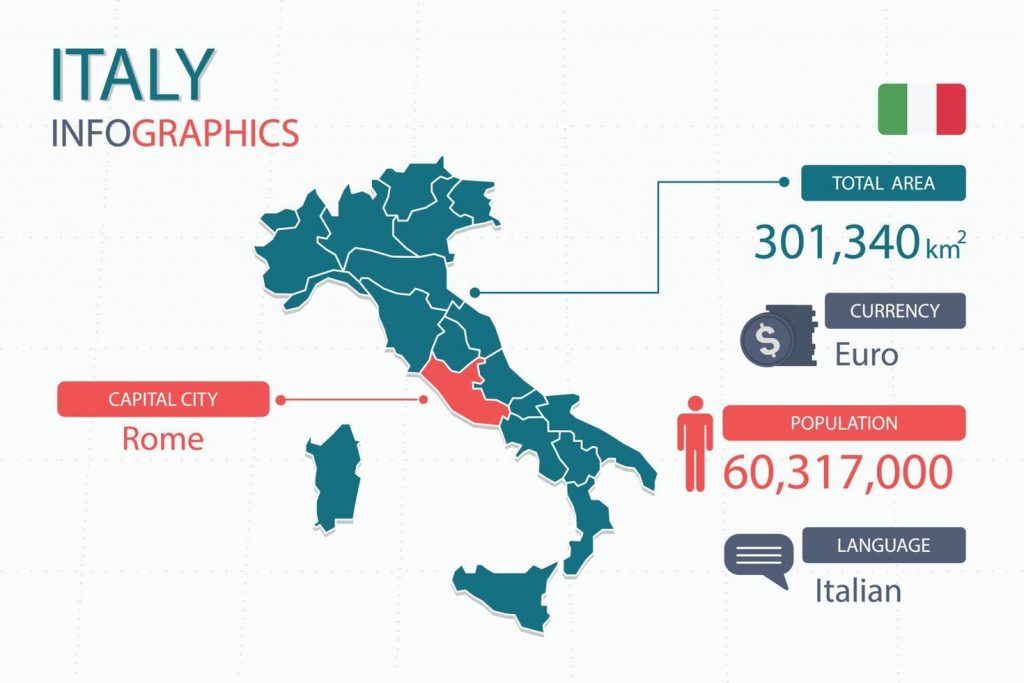The origins of the Italian Language
The Italian Language is considered a major world language that is the official language of Switzerland, Italy, Vatican City, and Western Istria, a peninsula shared by Croatia, Slovenia, and Italy. In addition, it is still prevalent in Monaco, Malta, and Albania, as well as in some regions of Africa. Because of large expatriate communities found in the Americas and Australia, areas, where Italian can be spoken, can be found in these places as well. It is considered a major or official language in many international organizations.
Features that make Italian unique are many. First, many scholars consider it the closest language to Latin out of all the Romance languages, as it seems to have preserved many of Latin’s characteristics. This includes a feature known as ‘gemination’, where there are short and long consonants. While many Romance languages have short and long vowels, it seems that Italian is the only one that has reserved this distinction for consonants as well. Other non-Romance languages that do have this distinction include Korean and Japanese.
Many features that make it similar to other Romance languages, but differentiate it from the majority of other languages include aspects of its grammatical system like word order and the gender system. In terms of word order, adjectives can be placed before or after the noun, whereas in English it is always before. Similar to French, Spanish, and other Romance languages, Italian nouns are classified into two genders: masculine and feminine.
While being a Romance language in terms of language family, Italian has come under the influence of other languages as well, in terms of vocabulary and terminology sources. These include languages ranging from Arabic to certain Germanic languages, due to a long history of contact and conquest with cultures and peoples who speak these languages.

The Italian language uses the Latin Alphabet, like all the other Romance languages. In the Italian version, however, only 21 letters are used. The letters j, k, w, x, and y are not officially part of the alphabet, but they do appear in loan and foreign words. In addition, there may be some ‘accents’ or marks on vowels as well, denoting a shift in the vowel sound.
The history of Italian, like all Romance languages, stems from the later periods of Latin, when Vulgar Latin, the spoken variety at that time, started to be replaced by more regional varieties. However, standard Italian as we know it today is very influenced by the literature and poetry, as opposed to its spoken form.
Throughout its history, Italy was always conceptualized as a group of independent city-states until recently. With this city-state perspective, different dialects also existed based on these city-states. These dialects were quite different in characteristics such as pronunciation and word choice. At the same time, they reflected the identity of the citizens of certain city-states. The people identified more with their city-state as opposed as to Italy as a whole. Beginning in the middle ages, however, Florence began to gather much economic clout. Because of this recognition from other regions as well, the Italian spoken and developed in this particular region, Tuscany, became the basis of an Italian language.
During the Renaissance, between the 14th-17th centuries, many events occurred that helped shape the Italian language to what it is today. A unification of Italy on a political scale started to occur, beginning with the invasion of Napoleon, and continuing with other political events among the Kingdoms and other political entities that existed in Italy at that time. Because of such developments, an overall Italian identity emerged, and along with technological advances such as the printing press, the Tuscany variety of Italian continued to be pushed as a standard variety across all Italian-speaking regions. With a concept of a unified Italian identity that had developed because of the previously mentioned sociopolitical contexts, there also emerged a question of what language to use as a representation of this new identity. At the time, this was termed ‘questione della lengua’ or the problem of language. This also helped encouraged a standardized Italian language and has helped Italian develop into the language as it exists today.
In modern times, Italian remains an important language, especially of literature, art, and music. Much literary work stemmed from the Renaissance, a cultural movement that started in Italy and overtook Europe. Italian is also known as the language of music; a lot of the musical terminology that exists today come from Italian. Italian cuisine and cooking techniques are also famous throughout the world, and with this, the spread of the Italian language in relation to these fields are also prominent. Names of common food items, dishes, and certain cooking techniques come from Italian, with obvious examples being pizza and pasta who are names that are not translated but stays the same as its written. Italian is also an important religiously as it is the main language of the Holy Sea, and the lingua franca in the Roman Catholic church. Finally, it is the third most spoken language in terms of native speakers in the European Union and will remain an important language for anyone considering translating into Italian.
VEQTA can provide you with a perfect Italian translator for your Italian translation, English to Italian translation and Italian to english translation for the your targeted locale. Our translations to Italian are created with your target audience in mind to meet your expectations.
If you need to translate Italian – Get in touch today!
A dedicated team of Italian translators who combines Experience, Specialized Subject Matter Expertise with Translation Practices to deliver quality second to none.
Italian Subject Expertise
Italian Translators
Italian Editors
Italian Copywriters
Italian Reviewers
Italian Voice dubbing
Italian Subtitling
Italian Transcription


